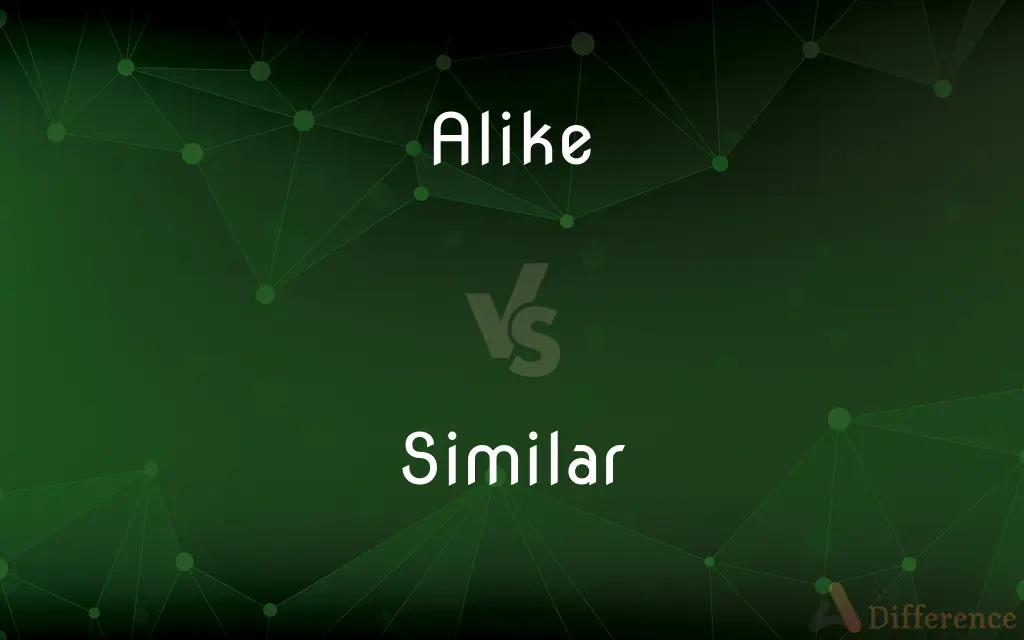Alike vs. Similar — What's the Difference?
By Tayyaba Rehman & Urooj Arif — Updated on March 15, 2024
"Alike" emphasizes sameness in appearance or nature, while "similar" denotes having common characteristics without being identical.

Difference Between Alike and Similar
Table of Contents
ADVERTISEMENT
Key Differences
Alike and similar are terms often used interchangeably, but they hold distinct nuances in their meanings. Alike implies a greater degree of resemblance or sameness, often used when two or more things are nearly indistinguishable in appearance or nature. On the other hand, similar suggests that while there are common characteristics, there are also differences. It's a comparison that acknowledges likeness without implying near or complete identity.
When we use alike, there's an implication of a more comprehensive or general resemblance, which might not only be physical but can also relate to behaviors, feelings, or abstract qualities. Similar, however, is more commonly used to draw specific parallels between certain attributes or features of things or people, without suggesting an overall indistinguishability. It highlights points of convergence while allowing for the presence of divergent qualities.
The choice between alike and similar often depends on the context and the extent of resemblance being communicated. While alike can suggest a more striking or complete resemblance, similar is more nuanced, acknowledging similarities while permitting differences.
Comparison Chart
Definition
Emphasizes sameness or likeness
Denotes common characteristics
Degree of Resemblance
Often closer or more comprehensive
Acknowledges differences
ADVERTISEMENT
Usage
General resemblance
Specific similarities
Connotation
Near indistinguishability
Likeness with distinctions
Context
Appearance, nature, behavior
Attributes, features, aspects
Compare with Definitions
Alike
Emphasizing sameness or likeness.
The siblings are so alike that it's easy to confuse one for the other.
Similar
Denoting common characteristics with some differences.
The designs are similar, each featuring a unique twist.
Alike
Can imply a very close resemblance.
The two paintings looked so alike, it was hard to tell them apart.
Similar
More specific in comparing particular aspects.
Their writing styles are similar, though each has a unique voice.
Alike
Suggests a high degree of similarity.
The houses in the neighborhood are all built alike.
Similar
Less about complete likeness and more about resemblance.
These two dishes taste similar but have distinct spices.
Alike
Often used in a broader sense.
They think alike on most political issues.
Similar
Acknowledges both similarities and differences.
The concepts are similar, but their applications differ.
Alike
Can be used for appearance, nature, or behavior.
The twins not only look alike but also act alike.
Similar
Often refers to specific attributes or features.
Their goals are similar, yet their methods vary.
Alike
Alike or Aalike (Village ID 617591) is a village in Bantwal taluk of Dakshina Kannada district, Karnataka, India. The languages spoken are Tulu, Kannada, Beary, Urdu, and Konkani.
Similar
Having a resemblance in appearance, character, or quantity, without being identical
Northern India and similar areas
A soft cheese similar to Brie
Alike
Having close resemblance; similar
The twins are as alike as two peas in a pod. Friends are generally alike in background and tastes.
Similar
A person or thing similar to another
He was one of those whose similar you never meet
Alike
In the same manner or to the same degree
They dress and walk alike.
Similar
A substance that produces effects resembling the symptoms of particular diseases (the basis of homeopathic treatment)
The principle of treatment by similars
Alike
Having resemblance or similitude; similar; without difference.
The twins were alike.
Similar
Having a resemblance in appearance or nature; alike though not identical.
Alike
In the same manner, form, or degree; in common; equally.
We are all alike concerned in religion.
Similar
(Mathematics) Having corresponding angles equal and corresponding line segments proportional. Used of geometric figures
Similar triangles.
Alike
Having resemblance or similitude; similar; without difference.
The darkness and the light are both alike to thee.
Similar
Having traits or characteristics in common; alike, comparable.
My new car is similar to my old one, except it has a bit more space in the back.
Alike
In the same manner, form, or degree; in common; equally; as, we are all alike concerned in religion.
Similar
(mathematics) Of geometrical figures including triangles, squares, ellipses, arcs and more complex figures, having the same shape but possibly different size, rotational orientation, and position; in particular, having corresponding angles equal and corresponding line segments proportional; such that one can be had from the other using a sequence of rotations, translations and scalings.
Alike
Having the same or similar characteristics;
All politicians are alike
They looked utterly alike
Friends are generaly alike in background and taste
Similar
Of two square matrices; being such that a conjugation sends one matrix to the other.
Alike
Equally;
Parents and teachers alike demanded reforms
Similar
That which is similar to, or resembles, something else, as in quality, form, etc.
Alike
In a like manner;
They walk alike
Similar
(homeopathy) A material that produces an effect that resembles the symptoms of a particular disease.
Similar
Exactly corresponding; resembling in all respects; precisely like.
Similar
Nearly corresponding; resembling in many respects; somewhat like; having a general likeness.
Similar
Homogenous; uniform.
Similar
That which is similar to, or resembles, something else, as in quality, form, etc.
Similar
Marked by correspondence or resemblance;
Similar food at similar prices
Problems similar to mine
They wore similar coats
Similar
Having the same or similar characteristics;
All politicians are alike
They looked utterly alike
Friends are generaly alike in background and taste
Similar
Resembling or similar; having the same or some of the same characteristics; often used in combination;
Suits of like design
A limited circle of like minds
Members of the cat family have like dispositions
As like as two peas in a pod
Doglike devotion
A dreamlike quality
Similar
(of words) expressing closely related meanings
Similar
Capable of replacing or changing places with something else;
Interchangeable parts
Common Curiosities
Can two things be alike but not similar?
Things that are alike have a strong resemblance, which inherently includes being similar; the terms are related but not exactly interchangeable.
Can inanimate objects be alike, or is it just for living things?
Inanimate objects can also be described as alike when they share a strong resemblance in appearance or nature.
How do alike and similar differ in terms of abstract concepts?
For abstract concepts, alike might suggest a more general or overall resemblance, while similar might point to specific shared characteristics.
Is it correct to say "very similar" but not "very alike"?
"Very similar" is commonly used, whereas "very alike" is less typical because alike often implies a strong resemblance already.
Does "similar" imply a comparison more than "alike"?
Similar often involves a comparison of specific characteristics, while alike can imply a broader, more general comparison.
Do "alike" and "similar" have the same degree of similarity?
Alike often suggests a closer resemblance than similar, which acknowledges more distinct differences alongside similarities.
Can "alike" and "similar" be used interchangeably in some contexts?
In many contexts, they can be used interchangeably, but subtle differences in connotation may make one more appropriate than the other.
Is "alike" more subjective than "similar"?
Alike might be considered more subjective as it often encompasses a general sense of resemblance that can vary in perception among different observers.
Are there situations where using "alike" or "similar" could lead to misunderstandings?
Misunderstandings could arise if the degree of resemblance implied by "alike" or "similar" is not clear, leading to different interpretations.
Can two opinions be alike?
Yes, two opinions can be alike if they are very similar or nearly identical in viewpoint.
Can "alike" ever imply a lesser degree of resemblance than "similar"?
Generally, alike implies a greater or complete degree of resemblance, while similar allows for more acknowledged differences.
How do cultural perceptions influence the use of "alike" and "similar"?
Cultural perceptions can affect the interpretation of what constitutes being "alike" or "similar," as standards of comparison might vary.
How do "alike" and "similar" function differently in scientific contexts?
In scientific contexts, alike might be used for broader or more general resemblances, while similar could be used for more precise or measured comparisons.
Can "similar" indicate a closer resemblance in some contexts than "alike"?
Typically, alike denotes a closer resemblance, but context can sometimes make similar seem to imply a strong likeness, especially with qualifying words like "very."
How do the nuances of "alike" and "similar" affect their use in literature and art?
In literature and art, the choice between alike and similar can subtly influence the interpretation of themes, characters, or styles, reflecting varying degrees of resemblance or commonality.
Share Your Discovery

Previous Comparison
Loppy vs. Sloppy
Next Comparison
Barky vs. DarkyAuthor Spotlight
Written by
Tayyaba RehmanTayyaba Rehman is a distinguished writer, currently serving as a primary contributor to askdifference.com. As a researcher in semantics and etymology, Tayyaba's passion for the complexity of languages and their distinctions has found a perfect home on the platform. Tayyaba delves into the intricacies of language, distinguishing between commonly confused words and phrases, thereby providing clarity for readers worldwide.
Co-written by
Urooj ArifUrooj is a skilled content writer at Ask Difference, known for her exceptional ability to simplify complex topics into engaging and informative content. With a passion for research and a flair for clear, concise writing, she consistently delivers articles that resonate with our diverse audience.















































